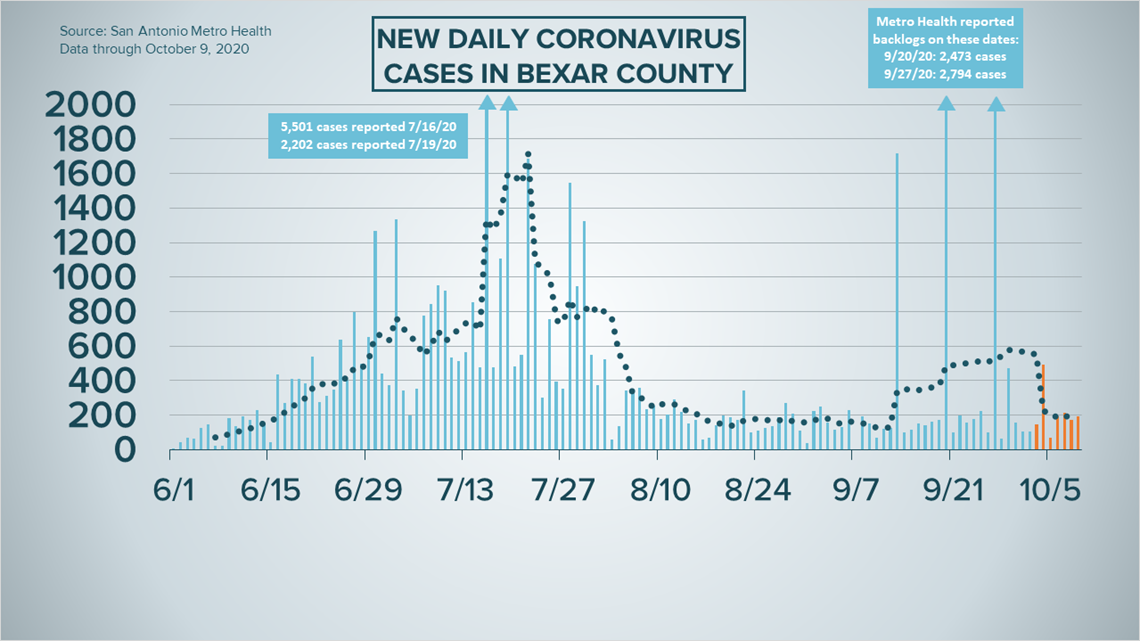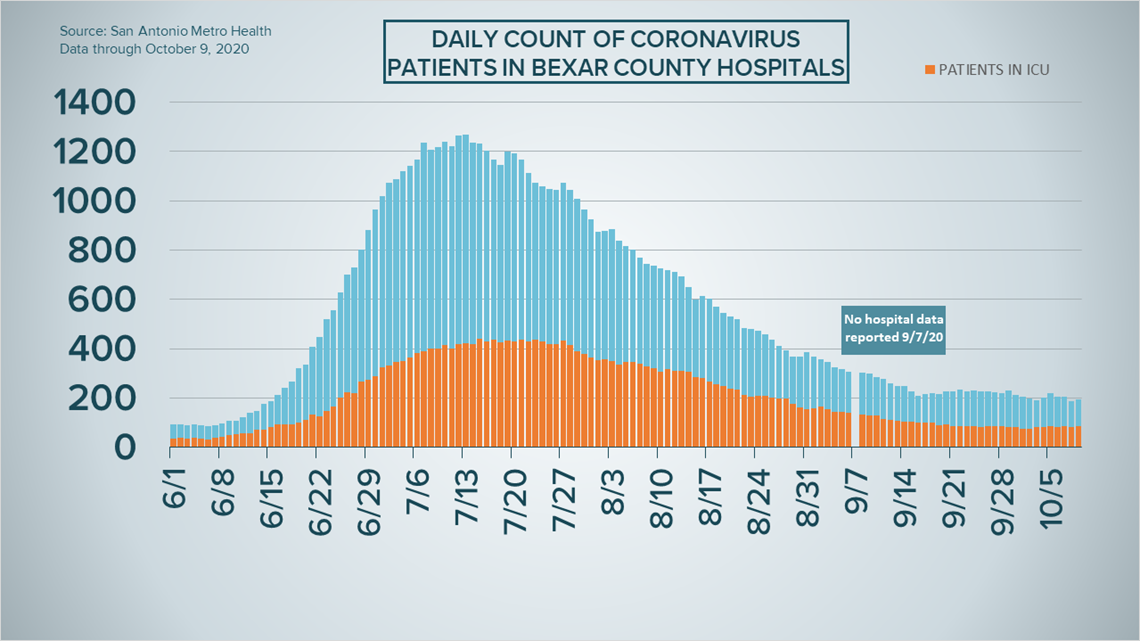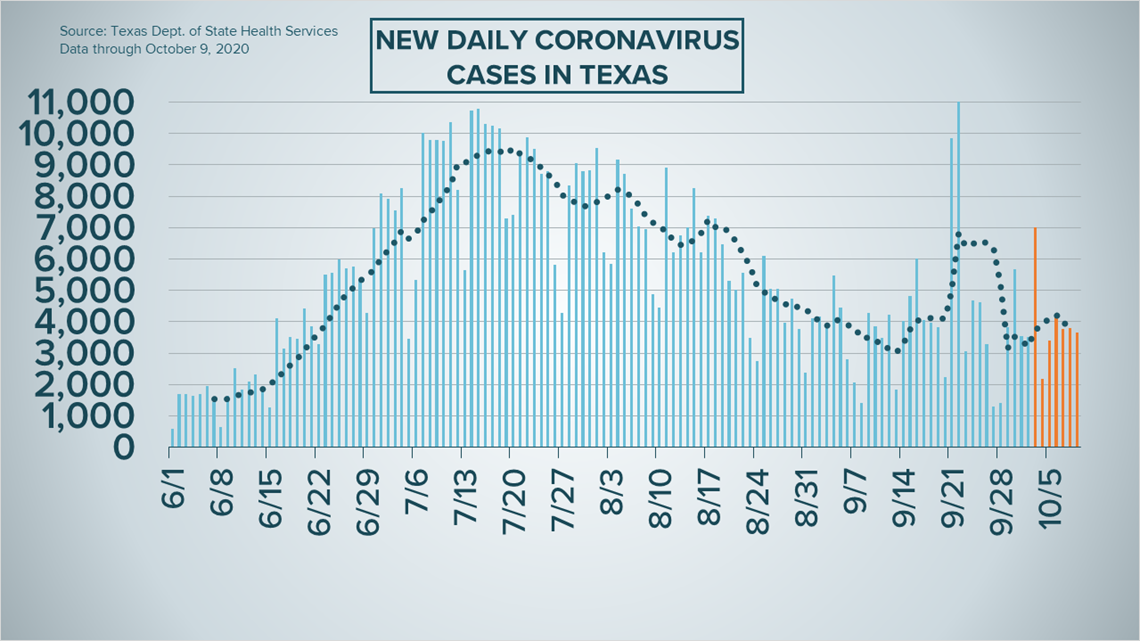SAN ANTONIO — We're tracking the latest numbers from the coronavirus pandemic in San Antonio and across Texas. Here are the latest numbers reported by Bexar and surrounding counties:
- Bexar County: 191 new cases were reported Friday, bringing the total number of cases for the county to 59,514. There were no new deaths reported, so the county's death toll remains at 1,171.
- Comal County: The county reported 16 additional cases and four more virus-related deaths on Friday. There have been a total of 3,550 cases of COVID-19 in the county – including 2,771 confirmed cases – while 120 county residents have died. County officials say there are 94 active coronavirus cases, and 3,336 residents are considered recovered.
- Hays County: Officials in Hays County on Friday reported 19 new cases in the county and no additional virus-related deaths. As of Friday, there are a total of 6,037 lab-confirmed cases in the county (963 of which are active) while the death toll remains at 55. 5,019 residents have recovered from the virus.
How Bexar County is trending
We've tracked how many coronavirus cases have been confirmed in Bexar County from the time officials began reporting cases in March 2020. The graphic below shows the number of cases since June and charts those daily case numbers along a 7-day moving average to provide a more accurate picture of the overall coronavirus case curve in our area and the direction we're trending amid the pandemic.
On Friday, San Antonio Mayor Ron Nirenberg announced another 191 COVID-19 cases in the county, raising the local total of diagnoses to 59,514 since the pandemic began.
However, Nirenberg also reported no new virus-related deaths in the county. 1,171 Bexar County residents have died from virus-related complications.


After a few consecutive days of decreasing hospitalization rates due to COVID-19 in Bexar County, the week is ending with an uptick. 193 Bexar County residents were receiving treatment for coronavirus symptoms on Friday, which is eight more than on Thursday.
The numbers of patients using ventilators (37) and in intensive care (84) are also up slightly from Thursday.


Coronavirus in Texas
The number of Texans who have tested positive for the coronavirus since the pandemic began grew by 4,036 cases on Friday, according to the Texas Department of State Health Services.
3,650 of those are new diagnoses over the last 24 hours, while the other 386 cases stem from a number of backlogs in several counties and groups of previously unreported cases in some areas. More details can be found at the top of this page.
In total, 785,830 coronavirus cases have been confirmed in Texas.


State health authorities, meanwhile, reported an additional 98 virus-related deaths on Friday. At least 16,432 Texans have passed away from COVID-19 complications.
Meanwhile, more Texans were hospitalized for coronavirus symptoms on Friday, continuing a troubling trend from over the past few days. There were 37 more Texans receiving treatment for COVID-19 in the last 24 hours, for a total of 3,593 currently hospitalized; Sept. 9 was the last time the state's figure was that high.
The state estimates that 698,481 Texans have recovered, while 72,546 Texans remain ill with COVID-19.
Meanwhile, the Texas Education Agency updated its online coronavirus database to show that there have been 12,847 cumulative cases among staff and students across the state as of Oct. 4. More information can be found here.
Latest Coronavirus Headlines
Coronavirus symptoms
The symptoms of coronavirus can be similar to the flu or a bad cold. Symptoms include fever or chills, cough, shortness of breath or difficulty breathing, fatigue, muscle or body aches, headache, new loss of taste or smell sore throat, congestion or runny nose, nausea or vomiting and diarrhea, according to the Centers for Disease Control.
Most healthy people will have mild symptoms. A study of more than 72,000 patients by the Centers for Disease Control in China showed 80 percent of the cases there were mild.
But infections can cause pneumonia, severe acute respiratory syndrome, kidney failure, and even death, according to the World Health Organization. Older people with underlying health conditions are most at risk.
But infections can cause pneumonia, severe acute respiratory syndrome, kidney failure, and even death, according to the World Health Organization. Older people with underlying health conditions are most at risk.
Experts determined there was consistent evidence these conditions increase a person's risk, regardless of age:
- Chronic kidney disease
- COPD (chronic obstructive pulmonary disease)
- Obesity (BMI of 30 or higher)
- Immunocompromised state (weakened immune system) from solid organ transplant
- Serious heart conditions, such as heart failure, coronary artery disease, or cardiomyopathies
- Sickle cell disease
- Type 2 diabetes
The CDC believes symptoms may appear anywhere from two to 14 days after being exposed.
Human coronaviruses are usually spread...
- Between people who are in close contact with one another (within about 6 feet).
- Through respiratory droplets produced when an infected person coughs, sneezes or talks. These droplets can land in the mouths or noses of people who are nearby or possibly be inhaled into the lungs.
- Some recent studies have suggested that COVID-19 may be spread by people who are not showing symptoms.
Help stop the spread of coronavirus
- Stay home when you are sick.
- Eat and sleep separately from your family members
- Use different utensils and dishes
- Cover your cough or sneeze with your arm, not your hand.
- If you use a tissue, throw it in the trash.

